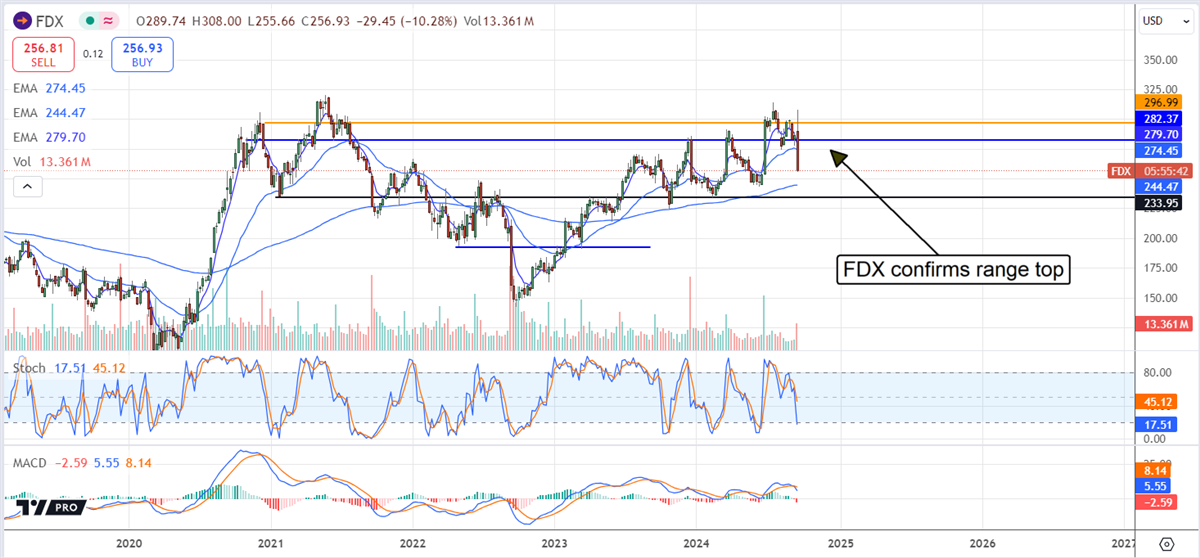The Warning Bell Tolling: FedEx Stumbles, Signaling Possible Economic Downturn
Amid the ever-shifting currents of the market, FedEx Corporation (NYSE:FDX) stands as a stalwart vessel. Yet, the recent storm brewing in their latest financial results has sounded a foreboding note for investors, hinting at the specter of an impending recession. The company’s lackluster performance across various metrics, falling short of growth expectations and issuing a tempered guidance, may mark the onset of a series of reductions that could span the year. The reverberations from FedEx’s stumble have rippled through the transportation sector, dragging down share prices for competitors such as United Parcel Service and J.B. Hunt Transportation Services (NASDAQ:JBHT).
As we brace for the imminent Q3 earnings season, the looming shadow of disappointment looms large. FedEx, along with its industry counterparts, serve as vital barometers for the broader economy. With FedEx failing to chart a course for growth this quarter, the impending data releases could paint a grim picture that spells trouble for the stock market at large.
Riding the Waves: FedEx Navigates Choppy Financial Seas
Despite the financial tempest, FedEx weathered the storm admirably, managing to keep its financial decks steady. While the company reported strong revenue and profits that are deemed sufficient to sustain its operations and capital programs, the net revenue of $21.16 billion saw a dip of 40 basis points from the previous year. This shortfall of 140 basis points from the consensus expectations hints at a deeper malaise, exacerbated by margin contractions impacting the bottom line.
The revenue constriction can be attributed to a shifting tide in consumer habits, redirecting them from higher-cost, higher-margin priority shipping to more budget-friendly alternatives. This mix shift has affected both operating segments, compounded by a calendar anomaly with one less day in the quarter. Even after accounting for this aberration, the results still fall short of expectations, accompanied by a shaky guidance that could be overly optimistic in its outlook.
While there have been strides in enhancing structural quality through initiatives like DRIVE, the margins have faced headwinds due to the consumer transition, with increases in wage expenses further squeezing profitability. Operating margins have contracted by 180 basis points on a GAAP basis and 170 basis points on an adjusted scale, resulting in a stark 23% drop in net income and a 20% decline in adjusted EPS. The mitigation from share repurchases, accelerated to the tune of $1 billion in Q1, has somewhat buoyed the adjusted EPS by $0.03, with plans for another $1.5 billion in buybacks by year-end.
Although the guidance offers a lifeline of sorts, painting a picture of sustainable operational and balance sheet health, the reality remains laden with challenges. With revenue growth expected by year-end, it is a tempered projection that mirrors the subdued demand and transitional consumer behavior seen in Q1. The pivot from a mid-single-digit revenue target to a low single-digit one, alongside a narrowed earnings outlook, sets the stage for what could be a protracted spell of economic headwinds persisting through CQ3 and CQ4. The ripple effect of FOMC’s rate cuts is but a distant beacon on the horizon, with their impact likely to manifest over several quarters.
Navigating the Financial Compass: Analysts Weigh In on FedEx’s Trajectory
Market analysts, much like seasoned navigators charting a course through choppy waters, have responded with lukewarm sentiments to FedEx’s recent performance. Post-release, a flurry of revisions has seen over a dozen adjustments, predominantly marked by downward tweaks to price targets and a smattering of downgrades. As the consensus target veers lower, the anticipated upside potential appears capped at the higher echelons of the trading range. While a lone increased target offers a glimmer of hope, the prevailing sentiment is that FedEx remains a buy, with a potential rebound contingent on forthcoming reports striking a more favorable chord.
The price action following the earnings report underscores a staunch resistance at the summit of the trading range. A 15% slump in the market post-report highlights the prevailing headwinds buoying prices at this level, with a trajectory poised to tilt further downwards in the upcoming weeks. The bastion of firm support lies in the vicinity of the $235 threshold, a milestone that seems increasingly within reach. However, the specter of waning market sentiment looms large, with the potential for FedEx’s stock to drift out of its range and aim for the $200 mark or lower. For investors eyeing an entry point, the prudent strategy would be to keep a watchful eye on this stock, biding time until it finds its footing once more in tandem with a brighter economic landscape.

The article “FedEx Stock Dips: Another Reason to Fear Recession Is Near” first appeared on MarketBeat.